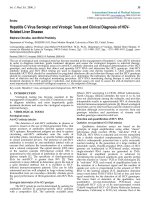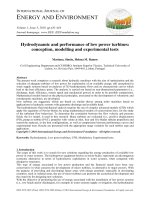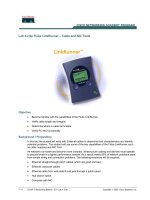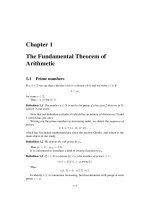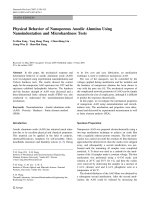IQ and aptitude tests
Bạn đang xem bản rút gọn của tài liệu. Xem và tải ngay bản đầy đủ của tài liệu tại đây (2.97 MB, 192 trang )
i
IQ AND
APTITUDE
TESTS
ii
[This page is intentionally left blank]
iii
IQ AND
APTITUDE
TESTS
Philip Carter
London and Philadelphia
iv
Publisher’s note
Every possible effort has been made to ensure that the information contained in
this book is accurate at the time of going to press, and the publishers and
authors cannot accept responsibility for any errors or omissions, however
caused. No responsibility for loss or damage occasioned to any person acting, or
refraining from action, as a result of the material in this publication can be
accepted by the editor, the publisher or any of the authors.
First published in Great Britain in 2007 by Kogan Page Limited
Reprinted 2007
Apart from any fair dealing for the purposes of research or private study, or crit-
icism or review, as permitted under the Copyright, Designs and Patents Act
1988, this publication may only be reproduced, stored or transmitted, in any
form or by any means, with the prior permission in writing of the publishers, or
in the case of reprographic reproduction in accordance with the terms and
licences issued by the CLA. Enquiries concerning reproduction outside these
terms should be sent to the publishers at the undermentioned address:
Kogan Page Limited
120 Pentonville Road
London N1 9JN
United Kingdom
www.kogan-page.co.uk
© Philip Carter, 2007
The right of Philip Carter to be identified as the author of this work has been
asserted by him in accordance with the Copyright, Designs and Patents Act
1988.
British Library Cataloguing in Publication Data
A CIP record for this book is available from the British Library.
ISBN-10 0 7494 4931 4
ISBN-13 978 0 7494 4931 5
Typeset by Saxon Graphics Ltd, Derby
Printed and bound in Great Britain by MPG Books Ltd, Bodmin, Cornwall
v
Contents
Introduction 1
1 Verbal aptitude 5
Test one: General verbal aptitude test 6
Test two: Word meanings test 11
Test three: Grammar and comprehension 16
Test four: Advanced verbal aptitude test 22
2 Spatial aptitude 33
Test one: General spatial aptitude test 34
Test two: Logical analysis test 46
Test three: Advanced matrix test 53
3 Numerical aptitude 59
Test one: Mental arithmetic 60
Test two: Numerical sequence test 63
Test three: Working with numbers 65
Test four: Numerical problem solving 74
4 IQ tests 78
IQ test one 80
IQ test two 94
IQ test three 107
IQ test four 122
5 Answers, explanations and assessments 135
vi
[This page is intentionally left blank]
1
Introduction
An aptitude test is, generally, any test designed to measure
potential for achievement.
The word aptitude is sometimes misused to mean ‘ability’ or
‘achievement’; however, there is a subtle difference between the
three words aptitude, ability and achievement, which can be
distinguished as follows:
• aptitude – how quickly or easily you will be able to learn in
the future;
• ability – what you are able to demonstrate in the present;
• achievement – what you have accomplished in the past.
There are nine different types of aptitude, which may be summa-
rized as follows:
• General learning: learning and understanding, reasoning and
making judgements. Example: how well we achieve at school.
• Verbal aptitude: general lexical skills – understanding words
and using them effectively.
• Numerical aptitude: general mathematical skills – working
with numbers quickly and accurately.
• Spatial aptitude: understanding geometric forms, and the
understanding and identification of patterns and their
meaning. Example: understanding how to construct a flat-
pack piece of furniture from a set of instructions.
• Form perception: inspecting and perceiving details in objects,
and making visual comparisons between shapes. Examples:
studying an object under a microscope, and quality inspection
of goods.
• Clerical perception: reading, analysing and obtaining details
from written data or tabulated material. Examples: proof-
reading, analysing reports and understanding graphs.
• Motor coordination: eye and hand coordination, and making
quick and accurate rapid movement responses. Examples:
actually being able to assemble the flat-pack piece of furniture
once you have understood how it should be done, being able
to operate a computer keyboard quickly and accurately, and
sporting skills.
• Finger dexterity: manipulating small objects quickly and
accurately. Examples: playing a musical instrument, and
sewing.
• Manual dexterity: the skill of being able to work with your
hands. Examples: painting and decorating, building things
and operating machinery.
In the case of most aptitude tests there is usually a set time limit,
which must be strictly adhered to in order for the test to be valid,
and there is usually an average score that has been standardized
in comparison with the scores of a group of people who have
taken the same test.
The tests that follow in Chapters 1, 2 and 3 are divided into
three main sections: verbal aptitude, spatial aptitude and
numerical aptitude.
Chapter 4 consists of four separate IQ tests, each consisting of
a mixture of verbal questions, numerical questions and questions
involving diagrammatic representation.
2 IQ and aptitude tests
Note: Because they have been newly compiled for this book,
the tests have not been standardized in comparison to scores
obtained by other groups. Nevertheless there is a guide to
assessing your performance at the end of each test and,
because several of the tests relate to specific aptitudes, the
results will give you the opportunity to identify your own
particular strengths and weaknesses.
Introduction 3
4
[This page is intentionally left blank]
5
Verbal aptitude
The definition of ‘verbal aptitude’ is the capacity for general
lexical skills – the understanding of words and the ability to use
them effectively.
People who possess a high level of verbal skills often excel in
fields such as writing (author, journalist, editor, critic), teaching
(language, drama), the legal profession (judge, barrister, lawyer)
and personnel work (advocate, human resources, counsellor) and
as actors, psychologists, interpreters and interviewers.
Mastery of words is seen by many as having in one’s possession
the ability to produce order out of chaos. Because of this it is argued
that command of vocabulary is an essential measure of intelligence,
with the result that verbal tests are widely used in IQ testing.
Verbal reasoning tests are designed to measure basic verbal
aptitude. Typically such tests include spelling, grammar, word
meanings, completing sentences, synonyms (words that are the
same or similar in meaning to each other) and antonyms (words
that are opposite in meaning to each other).
The exercises that follow test basic verbal aptitude in a number
of disciplines, including synonyms, antonyms, analogy, odd one
out and verbal comprehension.
For each test a performance assessment is provided. The time
limit that is specified for completing each test should not be
exceeded; otherwise your score will be invalidated.
1
Test one: General verbal aptitude test
This test is a miscellaneous selection of 30 questions designed to
measure language use or comprehension, and your ability to
adapt to different types of question.
You have 60 minutes in which to answer the 30 questions.
You should read the instructions to each question carefully
before attempting it.
1. Which word in brackets is most similar in meaning to the
word in capitals?
ERSTWHILE (fallacious, deviant, previous, honest, candid)
2. Which word in brackets is most similar in meaning to the
word in capitals?
PEDESTRIAN (plinth, ordinary, slow, erudite, rueful)
3. Which word in brackets is most similar in meaning to the
word in capitals?
TENABLE (believable, alluring, steadfast, delicate,
speculative)
4. Which two words are closest in meaning?
rubicund, recurrent, allied, frequent, routine, tolerable
5. Which two words are closest in meaning?
strange, formless, hectic, irregular, pallid, angry
6 IQ and aptitude tests
6. Which two words are closest in meaning?
conciliatory, propitious, inspired, fortunate, compatible,
routine
7. Which word in brackets is most opposite in meaning to the
word in capitals?
SOOTHE (augment, inflame, ignore, depress, execute)
8. Which word in brackets is most opposite in meaning to the
word in capitals?
PROSCRIBE (demolish, stifle, change, unify, allow)
9. Which word in brackets is most opposite in meaning to the
word in capitals?
GOAD (resolve, halt, dissuade, warn, retract)
10. Which two words are most opposite in meaning?
bright, exemplary, meteoric, fundamental, gradual, level
11. Which two words are most opposite in meaning?
superlative, traumatic, subversive, relaxing, crucial,
uncommitted
Verbal aptitude 7
12. Which two words are most opposite in meaning?
ancient, recant, evoke, maintain, dissent, stand
13. Which two words are most opposite in meaning?
susceptible, clandestine, extreme, credulous, banal, immune
14. Which is the odd one out?
inch, metre, litre, foot, kilometre
15. Which is the odd one out?
adieu, salutation, sayonara, farewell, ciao
16. Which is the odd one out?
appendix, prologue, supplement, addendum, postscript
17. Which is the odd one out?
immutable, eternal, transitory, imperishable, indelible
18. Which is the odd one out?
corporation, entrepreneur, business, firm, conglomerate
19. Which is the odd one out?
auburn, chestnut, walnut, carmine, hazel
8 IQ and aptitude tests
20. amplify is to augment as aggravate is to: elevate, maximize,
exacerbate, inflate, proliferate
21. Identify two words (one from each set of brackets) that form
a connection (analogy), thereby relating to the words in
capitals in the same way.
FLORA (vegetation, life, animals)
FAUNA (animals, plants, flowers)
22. Identify two words (one from each set of brackets) that form
a connection (analogy), thereby relating to the words in
capitals in the same way.
APHELION (planet, furthest, distance)
PERIHELION (nearest, sun, orbit)
23. Identify two words (one from each set of brackets) that form
a connection (analogy), thereby relating to the words in
capitals in the same way.
SQUARE (polygon, rectangle, rhombus)
CIRCLE (sphere, diameter, ellipse)
24. Identify two words (one from each set of brackets) that form
a connection (analogy), thereby relating to the words in
capitals in the same way.
SPRING (autumn, flower, bud)
SUMMER (tree, leaf, July)
Verbal aptitude 9
25. identical is to indistinguishable as comparable is to
(congruous, corresponding, analogous, homogeneous,
symmetry)
26. Which two words that sound alike, but are spelled differently,
mean:
require / to work or press into a mass
27. Which word means the same as the definitions on either side
of the brackets?
condition of extreme hardship ( ) to promise or
pledge
28. What word can be placed in the brackets so that it forms a
word or phrase when tacked on to the end of the first word,
and another word or phrase when placed in front of the
second word?
double ( ) bar
29. Which 3 of the 10 three-letter bits can be combined to
produce a word meaning deserving of respect or high regard?
ide, ima, ria, end, est, ent, ard, atu, ble, ile
30. Which 3 of the 10 three-letter bits can be combined to
produce a word meaning an authoritative rule?
ina, tas, ord, ula, ate, ian, nce, cel, ion, pet
10 IQ and aptitude tests
Test two: Word meanings test
This test measures your ability to distinguish between words that
are frequently confused or misused in correspondence and
conversation.
In each question you are provided with two definitions and two
words. You must place each word alongside its correct definition.
You have 30 minutes in which to solve the 30 questions.
1. a type of coarse cloth ____________________________
to solicit votes __________________________________
canvas, canvass
2. noun: one who depends __________________________
adjective: depending on __________________________
dependent, dependant
3. in that place ____________________________________
belonging to them _______________________________
their, there
4. impartial, unbiased ______________________________
lacking interest _________________________________
disinterested, uninterested
5. unbroken, connected ____________________________
frequent, repeated _______________________________
continual, continuous
Verbal aptitude 11
6. verb: to give an opinion __________________________
noun: opinion given ______________________________
advice, advise
7. how much? ____________________________________
how many? ____________________________________
amount, number
8. verb: to predict _________________________________
noun: prediction ________________________________
prophecy, prophesy
9. very small or unimportant ________________________
careless ________________________________________
negligent, negligible
10. unwilling, reluctant ______________________________
dislike intensely _________________________________
loath, loathe
11. making less dark ________________________________
discharge of electricity in atmosphere _______________
lightening, lightning
12. spirit of fortitude or endurance ____________________
of good conduct ________________________________
moral, morale
12 IQ and aptitude tests
13. verb: to bring about; noun: result __________________
verb: to act on, to influence ________________________
affect, effect
14. every two years _________________________________
twice a year ____________________________________
bi-annual, biennial
15. notice or point out likenesses ______________________
notice or point out differences _____________________
compare, contrast
16. body of water or electricity _______________________
small berry _____________________________________
currant, current
17. to hint _________________________________________
to deduce or conclude ____________________________
imply, infer
18. stated in detail __________________________________
implied but not expressed ________________________
explicit, implicit
19. impending, close at hand _________________________
abiding in, inherent ______________________________
immanent, imminent
Verbal aptitude 13
20. staff employed __________________________________
individual, private _______________________________
personal, personnel
21. smaller in amount _______________________________
smaller in number _______________________________
less, fewer
22. to inform ______________________________________
to evaluate _____________________________________
appraise, apprise
23. that which completes ____________________________
commendation, praise ___________________________
complement, compliment
24. faulty, incomplete _______________________________
falling short ____________________________________
defective, deficient
25. to turn aside, divert ______________________________
to take away from _______________________________
detract, distract
26. more than ordinary ______________________________
for a special occasion ____________________________
especially, specially
14 IQ and aptitude tests
27. naïve, innocent _________________________________
cleverly contrived _______________________________
ingenious, ingenuous
28. related to a judge, impartial _______________________
sensible, prudent ________________________________
judicial, judicious
29. examples ______________________________________
priority ________________________________________
precedence, precedents
30. work with another ______________________________
confirm, support a statement ______________________
corroborate, collaborate
Verbal aptitude 15
Test three: Grammar and
comprehension
This test is a miscellaneous selection of 15 questions designed to
measure language use or comprehension, and your ability to
adapt to different types of question, including several involving
the use of grammar and punctuation.
You have 90 minutes in which to complete the 15 questions.
1. As a craftsman he was extremely __________ at creating
artistic designs of metalwork and he was able to __________
his son’s suggestion to __________ several of these creations,
which enables them to be put to better use.
Insert the three words below into their correct positions in
the above sentence.
adopt, adapt, adept
2. The __________ had a __________ to remain __________ as
the train left the platform.
Which is the only one of the following combinations that
contains the correct three words to be inserted into the
above sentence?
a. superintendant, tendency, stationary
b. superintendent, tendancy, stationary
c. superintendant, tendency, stationery
d. superintendent, tendency, stationary
e. superintendent, tendency, stationery
f. superintendant, tendancy, stationery
Answer
អ
16 IQ and aptitude tests
3. Which one of the following sentences is grammatically
correct?
a. Although it’s true that the football team’s fame has spread
far and wide, it’s performance has been a great disap-
pointment to the manager throughout the current season.
b. Although it’s true that the football team’s fame has spread
far and wide, its performance has been a great disap-
pointment to the manager throughout the current season.
c. Although it’s true that the football teams’ fame has spread
far and wide, its performance has been a great disap-
pointment to the manager throughout the current season.
d. Although its true that the football teams’ fame has spread
far and wide, it’s performance has been a great disap-
pointment to the manager throughout the current season.
e. Although it’s true that the football teams’ fame has spread
far and wide, it’s performance has been a great disap-
pointment to the manager throughout the current season.
Answer
អ
4. Which one of the following sentences is grammatically
correct?
a. ‘Whose that young child?’ exclaimed the lady, whose
plants the child had just trampled down.
b. ‘Who’s that young child?’ exclaimed the lady, whose
plants the child had just trampled down.
c. ‘Who’s that young child?’ exclaimed the lady, who’s
plants the child had just trampled down.
d. ‘Whose that young child?’ exclaimed the lady, who’s
plants the child had just trampled down.
Answer
អ
Verbal aptitude 17
5. ‘I agree in ____________ that it is ____________ acceptable
for pupils to remove their jackets during classes in very hot
weather’, said the school ____________, ‘but they must
remain ____________ at all times.’
In which one of the following do the four words appear in
the correct order in which they should be inserted into the
above sentence?
a. principal, quite, principle, quiet
b. principle, quite, principal, quiet
c. principal, quiet, principle, quite
d. principle, quiet, principal, quite
Answer
អ
6. Which one of the following sentences is grammatically
correct?
a. The sisters’-in-law of the bride’s cousins made their way
into the church.
b. The sisters-in-law of the bride’s cousins made there way
into the church.
c. The sister’s-in-law of the bride’s cousins made there way
into the church.
d. The sisters-in-law of the bride’s cousins made their way
into the church.
e. The sisters-in-law of the brides’ cousins made their way
into the church.
f. The sister’s-in-law of the bride’s cousins made their way
into the church.
Answer
អ
18 IQ and aptitude tests
7. Quite a ____________ of ____________ can give
____________ ____________ to other ____________, but in
____________ that ____________ is not very ____________
____________, ____________ rather as a ____________ than
as a ____________.
Insert the 12 words below into their correct position in the
above sentence.
shocks most serving animals fish warning highly
number weapon electric capacity developed
8. Most roots, from branching trees to tiny plants, have large
herbs.
Change the position of five words only in the above
sentence so that it then makes complete sense.
9. For ____________ of ____________ ______________
____________ have tried to find ____________ ____________
in ____________ the ____________ of ____________
____________.
Insert the 10 words below into their correct position in the
above sentence.
famous hidden people compilers names hundreds
anagram meanings rearranging years
Verbal aptitude 19
